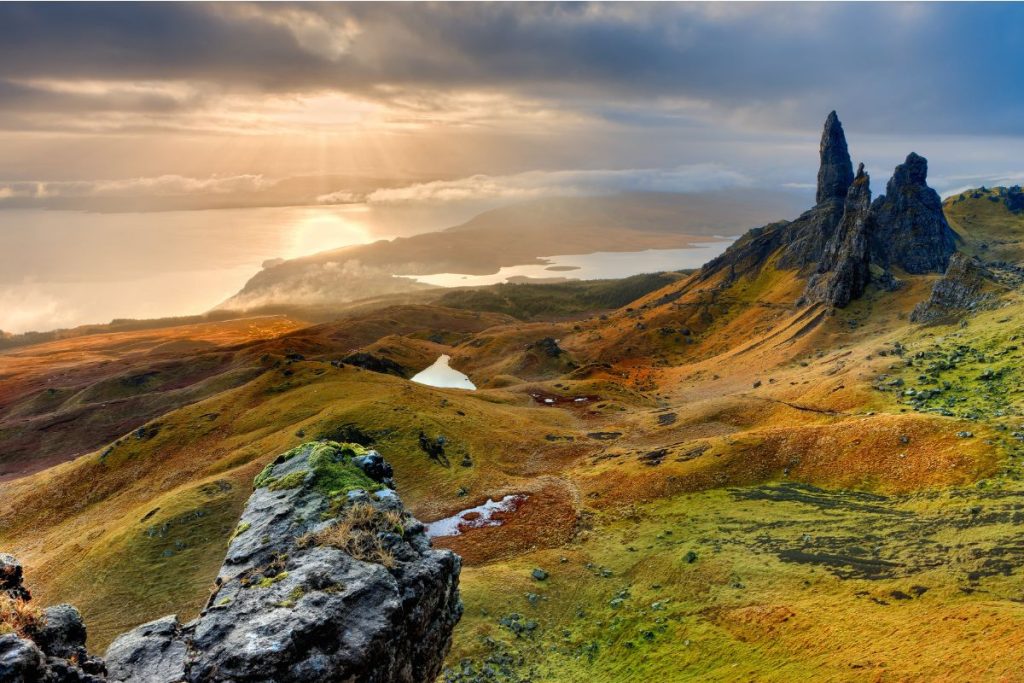Scotland has nearly 800 islands, many of which are uninhabited. The islands are divided into main groupings, which include the Orkney Islands, Shetland Islands, the Firth of Clyde, and the Inner and Outer Hebrides. Of the inhabited islands, many are connected to the mainland by bridge, while others are accessible only by ferry or plane. Each island has its own unique topography, history, culture and traditions. Here are some of the more popular islands to visit.

Shetland Islands
The Shetland Islands lie off the northeast coast of Scotland. Inhabited since around 3000 BC, the Shetland Islands were controlled by the Vikings and then later, Norway for several centuries. Today, the island still honors its Scandinavian heritage in its music, dialect, festivals and cuisine.

The relatively sleepy islands are home to the industries of oil, sheep farming, and fishing. Aside from enjoying lazy walks and the stunning scenery of the surrounding farmlands, dining on fresh seafood, and making friends with the delightfully diminutive Shetland ponies, there’s not much to do on the islands other than relax.
The Mainland, the largest and main island in the group, offers the most choice in dining and accommodations. It’s here that the ferry from Aberdeen will drop you off. But to reach the northernmost inhabited island in the UK, you’ll need to take a second ferry up to the remote island of Unst.
The Orkney Islands
Only 20 of Orkney’s 70 islands are inhabited. The oldest settlers were believed to have come to the Orkney’s around 3500 BC and many of Europe’s best-preserved Neolithic monuments remain. Like the Shetlands, Orkney’s main island is also called Mainland and is home to 75% of the island group’s population.

The town of Stromness is the largest on the Mainland and receives ferries from Scrabster on Scotland’s mainland. The Mainland’s climate is surprisingly mild and the topography diverse, making it a great stop for any nature enthusiast. Take a walk through nature reserves and along wild beaches and spot puffins clustered on sea rocks. You can also visit Highland Park, the most northerly Scotch whiskey distillery in the world, in Kirkwall.
Populations on the surrounding isles range from 500 to a mere 5. Most are dotted with Viking and Neolithic remains and many are havens for indigenous bird species. The Orkney Ferries company connects the majority of the islands.
The Firth of Clyde
Of the 40 islands in the Firth of Clyde, an inlet between the mainland of Scotland and the Kintyre peninsula on the southwest coast, only six are inhabited. The largest of the inhabited islands is Arran, often referred to as “Scotland in miniature” because the 167-square mile island demonstrates the vast variety of Scottish landscapes in a small area.

Visitors can wander Neolithic settlement remains, ride horses over rolling hills, walk along stony beaches and peek over sheer cliffs, taste whiskey at the local distillery, gather shrimp in tide pools, explore ruined castles, and enjoy a slower pace of life at small towns around the island.
Inner Hebrides
The Inner Hebrides are situated off the west coast of Scotland, to the south east of the Outer Hebrides. The largest and most northerly of these islands is the Isle of Skye. One of the most popular Scottish islands for tourists thanks to its accessibility (a bridge connects it to the mainland), Skye boasts charming harbor towns, and abundance of whiskey distilleries open to the public. The Cuillin Hills, a collection of rolling hills and towering rock formations, also lure those interested in hiking and mountain climbing.
The isles of Mull, with its picturesque town of Tobermory, and Islay, popular with bird-watchers and whiskey aficionados, are also located in the Inner Hebrides.

Outer Hebrides
The Outer Hebrides compose the westernmost of Scotland’s islands. Much of the area of the island chain is designated as a protected habitat, as it is home to eagles, sharks, whales, dolphins and otters. The majority of the islands are unpopulated; ferries link all the inhabited islands and the mainland.
Many people in the Outer Hebrides speak Gaelic and the culture here is strong. Religion is also important and many areas shut down completely on Sundays. The Outer Hebrides are a place to slow down and relax. Even the most populated islands of Lewis and Harris are still very quiet. Exploring sleepy villages, strolling along pristine beaches, and enjoying the flora and fauna of the islands will keep you busy enough, though many people also come to golf at one of the many island courses.

It would take a decade to explore all of Scotland’s fascinating islands, and that’s just the inhabited ones. Rather than stretch yourself too thin trying to see them all, concentrate on just one group at a time, based on your interests. Relax at the remote Shetland islands, commune with nature and explore ancient ruins in the Orkney’s, take a whirlwind mini-tour of Scotland on Arran Island in the Firth of Clyde, drink whiskey or get your adrenaline pumping on the Inner Hebrides, or escape from it all to the Outer Hebrides. No matter which you choose, Scotland’s majestic and untamed islands are sure to charm.
Ferry Links –
Hebrides and Firth of Clyde
Orkney and Shetland
Written by Katie Hammel for EuropeUpClose.com
